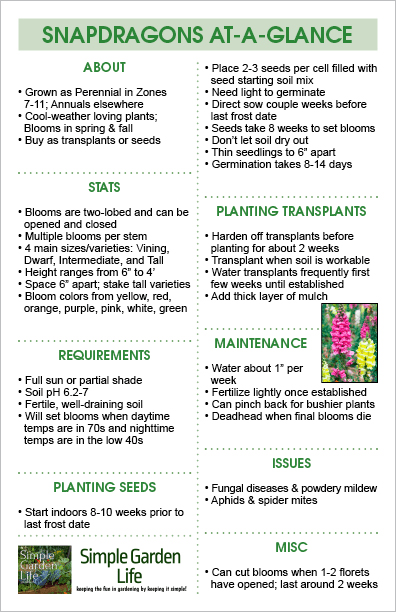Snapdragons, also known as antirrhinums, are a beloved garden staple famous for their vibrant, dragon-shaped flowers. These charming blooms not only add a splash of color to the landscape but also attract delightful pollinators such as bumblebees. Whether you’re an experienced gardener or a green-thumbed novice, proper care and understanding of snapdragons can ensure these beauties thrive in your outdoor space.
How to grow dazzling snapdragons
Snapdragons (Antirrhinum majus) boast an array of colors and sizes, making them a versatile choice for any garden. Cultivating these plants begins with selecting the right location—a spot with full sun to partial shade and well-drained soil. To add to their allure, they’re also available in a variety of forms, from tall, stately spires to compact, bushy mounds that are perfect for the front of a border or in garden containers.
When planting snapdragons, it’s important to consider spacing. Plant them far enough apart to ensure good air circulation, which helps prevent disease. As they grow, staking taller varieties can prevent them from toppling over. Regular deadheading encourages snapdragons to produce more blooms, extending their flowering period.
For those in cooler climates, snapdragons are an excellent choice. They thrive in the cooler parts of spring and fall, often slowing down in the heat of summer. In regions with mild winters, they can even survive to bloom again the next season, showcasing their resilience and perennial nature.
What is the best way to care for snapdragons?
Proper care for snapdragons involves regular watering, especially during dry spells. However, be careful not to overwater, as this can lead to root rot. Feeding the plants with a balanced fertilizer can promote growth and flowering. Moreover, maintaining fertile soil enriched with organic matter can enhance their health and vibrancy.
Deadheading, or the removal of spent flowers, is crucial to encourage new blooms. This not only keeps your snapdragons looking tidy but also directs energy towards the production of more flowers. For prolonged blooming, consider cutting back the plants by one-third mid-season to refresh them and spur a new wave of growth and flowering.
While generally hardy, snapdragons can fall prey to pests and diseases. Keeping an eye out for common issues like rust, powdery mildew, and aphids is important. Treating problems early is key to preserving the health and beauty of your snapdragons.

When and where to plant snapdragons?
Snapdragons are somewhat unique in their planting schedule. They should be planted after the danger of frost has passed in spring. However, they can also be planted in late summer to early fall in many areas, as they thrive in the cool temperatures of autumn.
Choose an area with full sun to partial shade for the best results, as snapdragons bloom most prolifically with at least 6 hours of sunlight daily. The soil should be rich and well-drained, as snapdragons don’t like wet feet. In terms of location, they are excellent for borders, flower beds, and as a pop of color along walkways.
For those in USDA hardiness zones 7 to 11, snapdragons can often survive winter and return the following year, behaving more like perennials. In cooler zones, they are typically grown as annuals.
How to grow snapdragons from seed indoors?
- Start by sowing seeds in trays or pots with well-draining seed starting mix about 8-10 weeks before the last frost date.
- Cover the seeds lightly with soil, as snapdragon seeds need light to germinate.
- Keep the soil moist but not waterlogged, and place the trays in a warm, bright spot.
- Once seedlings emerge, provide plenty of light to prevent them from becoming leggy.
- When they have developed a few sets of true leaves, transplant them into individual pots to grow on until it’s time to harden them off and move them outdoors.
What are the common problems with snapdragons?
Snapdragons are relatively easy to care for, but they can encounter a few common problems. Rust, a fungal disease, can cause orange spots on leaves and stems. Good air circulation and avoiding overhead watering can help prevent this issue. Aphids and other sucking insects can also be problematic, detracting from the plant’s health and appearance.
Additionally, snapdragons might experience root rot if they sit in waterlogged soil. Ensuring proper drainage and not overwatering are key preventative measures. If plants are infected with a disease, it’s often best to remove the affected parts or even the whole plant to prevent spreading.
Frost damage can occur if snapdragons are planted too early in the spring. Covering them with a frost cloth can protect them from unexpected cold snaps.

How to keep snapdragons blooming throughout the season?
Deadheading is the most effective way to keep snapdragons blooming. By removing spent blooms, you encourage the plant to produce more flowers. Additionally, a mid-season trim can rejuvenate the plants. Fertilizing every few weeks with a balanced fertilizer can also boost blooming.
Ensuring that snapdragons receive adequate water, especially during dry periods, is crucial. However, watering in the morning can reduce the risk of diseases that thrive in damp conditions. Mulching around the plants can help maintain soil moisture and temperature, further promoting continuous blooms.
Where to use snapdragons in your garden?
Snapdragons are incredibly versatile and can be used in various garden settings. Plant them in borders for a burst of color, or use them to create a colorful edging along paths. They also work beautifully in flower beds, mixed with other annuals and perennials to create a layered look.
For urban gardeners, snapdragons are perfect for growing in containers. Place them on balconies, patios, or even as a cheerful welcome by your front door. They can also be part of a cottage garden scheme, contributing to a charming, informal display.
Lastly, snapdragons make excellent cut flowers. Their tall spikes and vibrant colors are ideal for bouquets, adding height and interest to floral arrangements.
Common questions about growing snapdragons
Are snapdragons annuals that I have to start afresh each year, or perennials that last for years?
In most climates, snapdragons are treated as annuals, as they tend to decline after their first blooming season. However, in milder climates, such as USDA zones 7-11, they can behave as short-lived perennials, coming back for several years.

For those in cooler zones who wish to see snapdragons return, providing protection over the winter, such as mulch or frost cloth, can help them survive.
Can I collect the seeds from my snapdragons and grow more?
Absolutely! Collecting seeds from snapdragons is a simple and economical way to propagate these flowers. Allow a few blooms to fade and develop pods, then harvest the seeds once the pods are dry. Store them in a cool, dry place until you’re ready to plant them.
Planting snapdragon seeds can be a rewarding experience, especially when you see the new plants come to life in your garden.
I cut some snapdragons to arrange in a vase, but the stems are crooked. How can I straighten them?
For crooked snapdragon stems, try recutting the stems at a sharp angle and placing them in warm water for a few hours. This can sometimes help them straighten out. However, embracing their natural curve can add character to your floral arrangements.
If straightening is essential, consider using a floral sleeve or gently wrapping the stems in paper to guide them as they hydrate.
What USDA zones do snapdragons grow in?
Snapdragons are commonly grown in USDA hardiness zones 7 through 11. They are cold-tolerant and can often withstand light frosts, making them a great addition to spring and fall gardens in these zones.

In zones with milder winters, snapdragons can sometimes overwinter and rebloom the following year, functioning as perennials.
Are antirrhinums and snapdragons the same thing? And what is a false snapdragon?
Yes, antirrhinums are commonly known as snapdragons. They belong to the genus Antirrhinum and are characterized by their snout-shaped flowers. A false snapdragon, or Penstemon, is a different plant that bears some resemblance to snapdragons but belongs to a separate genus.
While they may look similar, false snapdragons are not closely related to true snapdragons and may have different care requirements.
Where to buy snapdragons?
Snapdragons can be purchased at most garden centers, nurseries, and online plant retailers. They are typically available as seeds or young plants, ready to be transplanted into your garden. For a wider selection of varieties, consider looking at specialty flower and plant catalogs or websites.
Remember, when choosing snapdragons, consider the height, color, and growth habit that best fits your garden’s design and your personal preferences.
Incorporating a video tutorial can be particularly helpful for visual learners looking to master snapdragon care. For example, take a look at this informative video on the subject:

With the right care and conditions, snapdragons can be a dazzling addition to any garden. Happy planting and enjoy their enchanting beauty!
 How to grow Brussels sprouts
How to grow Brussels sprouts
